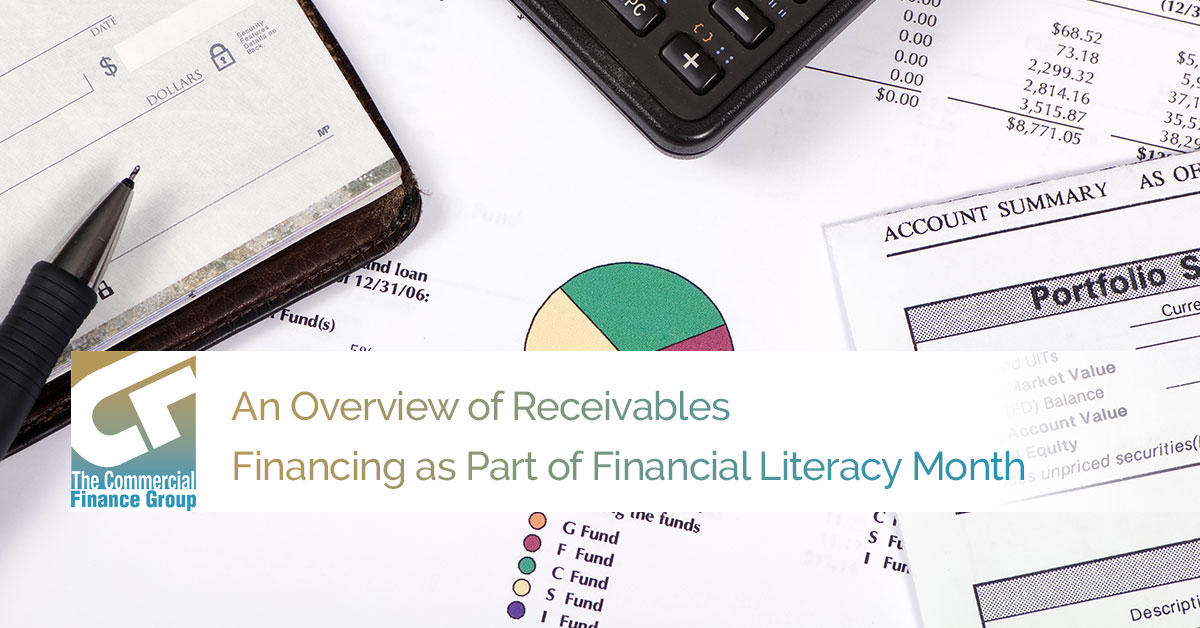In an effort to highlight and emphasize the importance of financial literacy and teach Americans across the country how to properly establish and maintain healthy financial habits, the United States recognizes National Financial Literacy Month every April. As a financial service that helps small business owners and other business professionals work through their accounts receivable issues, we support the effort to educate our country’s people on financial matters, even if National Financial Literacy Month doesn’t solely concern receivables financing.
Sometimes people tend to forget the basics of the things that they once learned, even if they practice those things every day through their chosen vocation. The Commercial Finance Group believes that everyone should at least have a good basic understanding of financial matters, including receivables financing. Even if you don’t own a business or work in accounting, you might be surprised when this knowledge comes in hand.
To pay our respects to April’s National Financial Literacy Month, we figured that it was only appropriate to go through the nuances of the receivables financing services that we offer at our Atlanta, Burbank and Los Angeles locations. Without further ado, let’s take a closer look at receivables financing and related financial matters.
High-Level
In essence, accounts receivable financing is a certain type of asset-financing arrangement in which a company uses its receivables as collateral in a financing agreement. Receivables are outstanding invoices or money that is owed by customers. In this financing agreement, an accounts receivables financing company like The Commercial Finance Group gives the original company an amount equal to a reduced value of unpaid invoices or receivables.
So what benefit does accounts receivable financing create for companies? Well, this type of financing helps companies free up their capital that is otherwise stuck in unpaid debts. Additionally, accounts receivable financing also transfers the default risk, or the chance that companies or individuals are unable to pay the required payments on their debt obligation, that is associated with the accounts receivables to the financing company.
Loan Advancement
Typically, most accounts receivables financing companies like The Commercial Finance Group advance about 70 to 90 percent of the value of their client’s outstanding invoices. After the initial loan advancement, the factoring company usually collects the debts and pays the original company the remainder of the amount collected minus a factoring fee.
Not a New Practice
Accounts receivable financing, as it turns out, actually goes back many centuries into its more primitive form. The origin of accounts receivable financing lies in overseas trade among nations. As early as the 1400s, accounts receivable financing became a fairly normal part of doing business in England and came to America with the Pilgrims in 1620. Like nearly any financial tool ever produced, factoring has evolved over the years. As a developing form of business loans, financing for accounts receivable operations grew in the United States as an effective way for companies to build more cash flow, primarily due to limitations that companies faced securing loans in the country’s rather fragmented banking system.

Why It’s Better Than Waiting for Customers to Pay
Waiting on customer payments can be a very long and grueling process. The wait on customer payments can also limit the amount of cash that your company has on hand in order to meet various expenses and achieve financial goals – if you don’t have this capital, that’s not good.
The main benefit of accounts receivable financing is quick payments on your invoices. Hypothetically, if your company averages $100,000 in receivables each month, you’d have nothing to show for it at the end of the month if your customers are waiting longer than 30 days to pay. With accounts receivables financing or factoring loans, you can ensure that you receive cash on each and every one of those invoices immediately. The amount, of course, depends on your advance rate. Even at 70 percent rate, that’s still $70,000 more than you otherwise would have by the end of the month.
Additional Benefits of Receivables Financing
Though boosting cash flow is the main reason that most companies get involved with account receivables financing, receivables financing also provides additional advantages for companies – especially small businesses. We’ll go over a few of them:
- Receivables financing is scalable: the amount of funding can grow as your receivables grow. It’s a two-way street that encourages progressive business growth.
- Receivables financing is not a loan, meaning that your business does not incur any debt when you get a receivables financing loan.
- Receivables financing can be customized and managed so that it provides necessary capital when your company needs it.
- Receivables financing is based on the quality of your customers’ credit, not your own credit history or business history. In this case, make sure you do business with reliable, reputable customers.
- Receivables financing provides free back-office support, including managing collections from your customers. This gives you, as a busy small business owner, more of the crucial time and resources that you need to grow your own company.
Recourse and Nonrecourse
Recourse factoring, or receivables financing, means that the factoring client ultimately takes responsibility for payment of an invoice if the factor cannot collect payment from the customer, or debtor.
On the other hand, nonrecourse factoring allows companies to sell their invoices to the factoring company, which actually assumes all of the credit risks for collecting on the invoices. Some receivables financing companies actually offer both recourse and nonrecourse factoring services to their clients, but not all receivables financing companies do this.
Receivables Financing vs Traditional Bank Loans
There are numerous reasons as to why accounts receivable financing is a much better solution for businesses than traditional bank loans. For one, factoring is a quicker, more flexible way for businesses to build up their cash flow. Also, with factoring, the amount of money that you can finance grows as your receivables grow, whereas, with a bank loan, the money you borrow comes with a cap or a limit.
Time is a huge factor when it comes to the difference between accounts receivable financing and traditional bank loans. With our services at The Commercial Finance Group, it can take less than five days to set up an account, but with a bank loan, securing a loan or a line of credit can take a painful one or even two months. As a small business owner who relies on your capital supply, you simply just don’t have the time for that.
We Embrace National Financial Literacy Month
Americans and people around the world should have a good sense and understanding of the world of finance, not just banking professionals. While we all can’t specialize in this industry, it’s useful to at least be familiar with the various terminology that comes from the finance world, so that doing things like filing taxes or running the financial aspects of a small business aren’t quite so difficult.
If you’re having any troubles with your accounts receivable operations, or find your business lacking the capital it needs to excel and grow, then you should get in touch with our professionals over at The Commercial Finance Group. Our receivables financing and accounts receivable factoring services will get your business on the right track because we believe that the growth of a business shouldn’t be stunted by a lack of capital. Contact our accounts receivable financing service today to see what we can do for your business.







